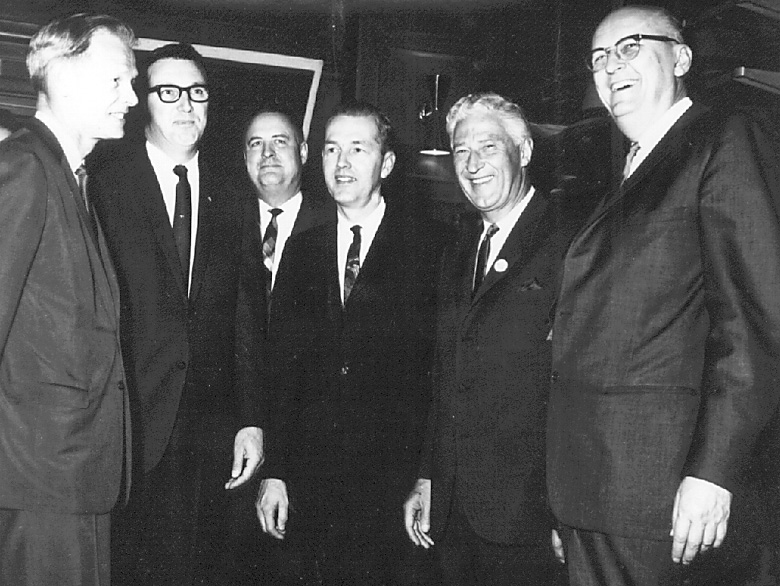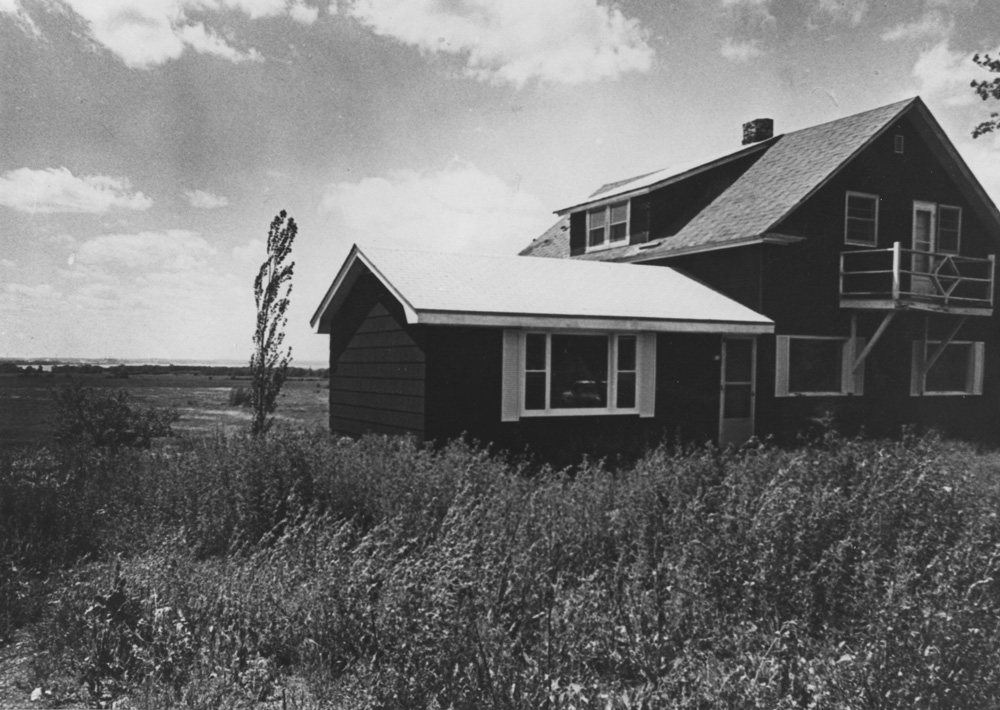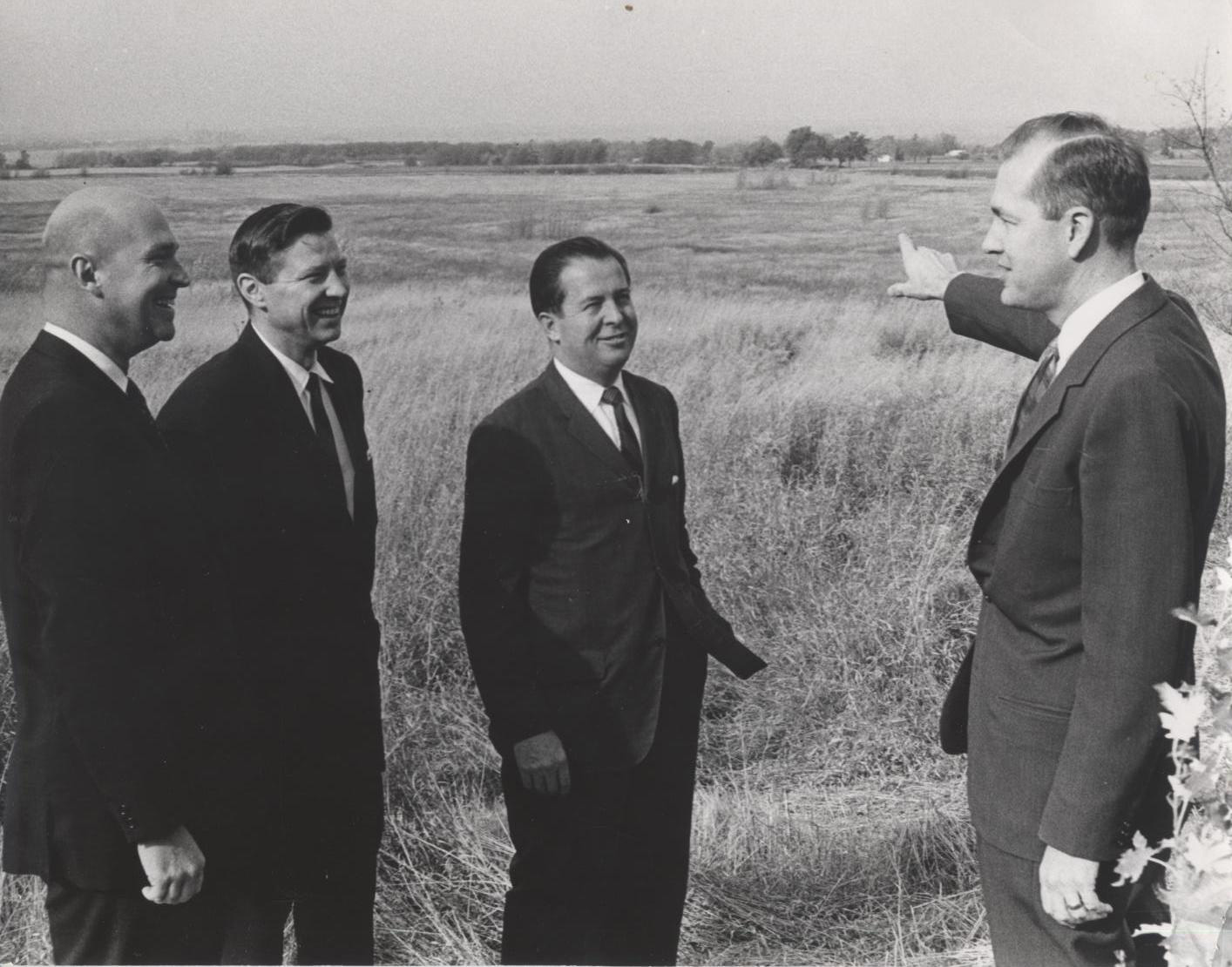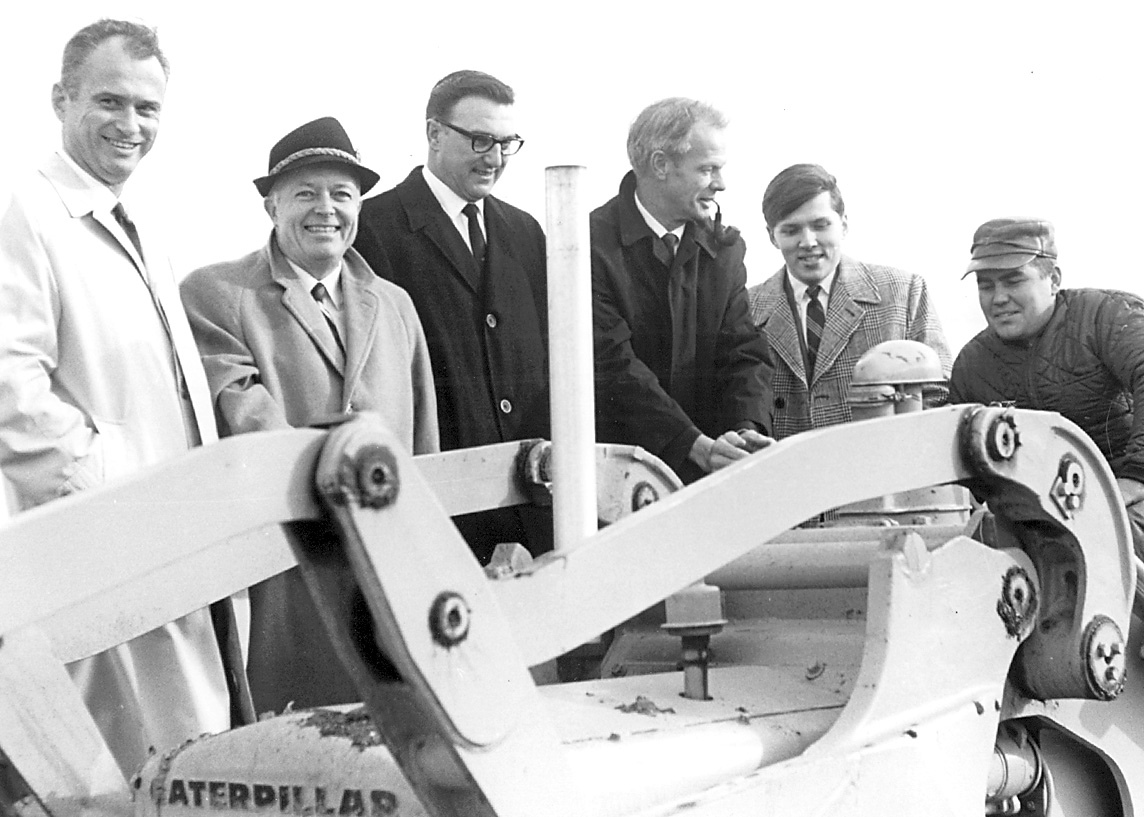Chapter Three: Fall 1966–Fall 1968
Our extensive search has produced an outstanding man for this important position. He has the scholarly and the administrative ability, the drive and the flexibility that leadership of this undertaking requires, that promises success for it.”
- UW President Fred Harvey Harrington, in a news release announcing the appointment of Chancellor Edward W. Weidner, Oct. 6, 1966
The appointment of Weidner ended nine months of work by a search committee appointed by President Harrington and headed by L.H. Adolfson, chancellor of the University of Wisconsin Center System. Other members included Harry Guilford, who taught at the Green Bay Center, and Elmer Havens of the Fox Valley Center faculty; both would later be selected to teach at the new University.
At its first meeting in February 1966, the search committee sifted through a list of 35 prospects for the two new chancellor positions—mostly academics of high rank, but including a few business executives and government officials. Through the weeks that followed, as Harrington kept in touch with committee deliberations, some names were eliminated and others added.
March, April and May went by without filling the top job at either of the new universities. But in June the committee found a chancellor for the southeastern campus, by now known as the University of Wisconsin-Parkside. Early in August, with no one in sight for Green Bay, Harrington suggested the name of Edward W. Weidner, a young political scientist who had recently taken a position in the vice president's office at the University of Kentucky. The two men had worked together some years earlier in Mexico City, when Harrington was head of an Agency for International Development mission to the University of the Americas.
Weidner, at 45, had already chalked up an impressive record as professor, scholar and administrator. A Phi Beta Kappa graduate of the University of Minnesota, he continued his studies there through the Ph.D. and in 1945 began his academic career as a lecturer in political science at UW Madison. Just seven years later, at the age of 31, he had achieved the rank of full professor and chairmanship of the political science department at Michigan State University.
Weidner spent 11 years at Michigan State. During the last five, from 1955 to 1960, he traveled and lived in South and Southeast Asia as coordinator of a technical assistance project and director of the MSU Institute for Research on Overseas Programs. To an already substantial list of publications, the experiences of his years overseas yielded three books and numerous book chapters, published articles and reports. In 1961, on leave from Michigan State, Weidner went to the University of Hawaii as a visiting scholar at the Center for Cultural and Technical Interchange Between East and West, soon known as the East-West Center. He stayed there for five years before accepting the position in Kentucky. During his last four years in Hawaii he served as vice chancellor of the center's Institute for Advanced Projects.
Weidner and his family had lived in Kentucky for only a few months when Harrington and the search committee sought him out to head the new institution in Northeastern Wisconsin. The regents moved quickly to approve the committee's choice and announce the appointment. The Weidners were officially welcomed to the community at a cocktails-and-dinner reception Oct. 29 at the Northland Hotel. They were joined in the receiving line by Gov. Knowles and President and Mrs. Harrington. Rudy Small presided over the festivities.
In brief remarks that closed the evening, Weidner picked up on several themes from the first campus planning report. He declared that the new institution would have a statewide rather than a local mission, and suggested some areas that might become “fertile academic fields to till”in a quest for distinction in Wisconsin's higher education enterprise. He ended his talk with a tribute and a challenge to those who had brought the University to birth:
“While remaining true to the purpose of a university and to the important philosophy underlying liberal education, we may also find real advantages in students understanding the immediate community surrounding them as a means of extending their insight into the country as a whole and the world beyond,” he said.“What better way to begin than to concentrate on some of the aspects of the physical environment of Northeastern Wisconsin, its health and recreation activities or its economic and social development programs?
“The community has contributed significantly to the founding of the new campus,” he acknowledged. “But my message tonight is less one of thanks than of invitation. Your work—our work—has just begun.”

Welcome reception at the Northland Hotel (L-R) Don Tilleman, Myron Lotto, Jerome Quinn, Edward W. Weidner, Warren Knowles, Fred Harvey Harrington
Just two years earlier President Harrington had suggested, at another dinner in Green Bay, that Northeastern Wisconsin might be considered as the location for a new university. Now a chancellor had been chosen for the campus, but the controversy over its location continued. A legal challenge to the site selection process from the Fox Cities group, still pending in the courts, would soon be joined by legis-lation introduced by Rep. William Rogers of Kaukauna. The Rogers bill sought to overturn the selection committee's decision in favor of the Larsen site on the west side of Green Bay.
Weidner, still occupied with responsibilities in Kentucky, could not take the reins full time until Feb. 15, 1967, the effective date of his full-time appointment. In the interim, though, he traveled frequently to Wisconsin. In Madison he sought out legislators and consulted with UW administrators; in Green Bay he met with community leaders and started to recruit his staff. Between visits he produced a flood of letters, memos, speeches and planning documents, and began to sketch in the details of an academic plan in keeping with guidelines already approved by the regents. He made it clear that he was resolved to stay out of the site dispute and “work with the site they give me.” But when the Building Commission voted to cut construction funds for the two campuses to $12.8 million—from a proposed budget of $26.7 million—Weidner joined Chancellor Irvin Wyllie of UW-Parkside in protesting the action. Together they warned that any further cuts could seriously damage the quality of the new institutions.
Funds for the first phase of construction were approved by the Legislature and accepted by the regents in July. But in the same month the Rogers bill won approval of the Joint Finance Committee after an unsuccessful fight led by Sen. Warren to kill the measure. The bill passed the Assembly and moved to the Senate.
Closer to home, the Brown County board confronted a site problem of its own. After a month of fruitless negotiations to buy the Shorewood Country Club property, the board had initiated condem-nation proceedings. Their action touched off a court battle that would simmer for almost two years.
Once settled on the campus—in modest quarters at the edge of an oat field—Weidner worked to refine an academic plan. The University would be organized as four “theme” colleges: Environmental Sciences, Community Sciences, Health and Leisure Time (soon to be renamed Human Biology) and Creative and Communication Arts (later Creative Communication and eventually Communication and the Arts). After consulting with community advisory groups on nearly every phase of university life, Weidner organized a series of academic planning seminars that would bring professors and administrators from across the country to consult on curriculum. The first seminar, held in July with 21 participants, focused on programs in the environmental sciences. At other meetings through the summer and fall, Weidner and his advisers formulated plans for liberal education seminars, off-campus programs and professional studies as well as theme college curricula. Weidner also worked to expand an administrative staff that at the time included, besides himself, only two senior aides: Russell White, assistant chancellor for administration, and Robert Maier, assistant chancellor for instruction and research. White came from the vice presidency of Transylvania College in Kentucky, and Maier from the University of Arizona administration. By November 1967 the regents had also approved appointments of five deans and directors and several faculty members.

Maloney farmhouse, Chancellor's Office 1967-1972
Nine months after arriving in Green Bay, Weidner could point to a number of major accomplishments. Curriculum development was on schedule; key administrators were on the job; construction funds had been appropriated and plans for the first buildings were taking shape. But except for two farmhouses on the Shorewood property, the University as a physical entity was still invisible. Weidner and his secretary occupied the first floor of the Maloney house, located down a steep hill from Bay Settlement Road. White worked in another farmhouse facing Highway 54-57, and others carried out their duties in plywood-walled cubicles in a warehouse above a Main Street discount store. In the open spaces of the warehouse, a small library staff worked at the acquisition and cataloging of the first library collections. Faculty members occupied offices at the Green Bay Center.

Campus site tour, September 1967 (L-R) Robert Maier, Raymond D. Vlasin, Russell White, Edward Weidner

Ground breaking for the University's first buildings: (L-R) Rudy Small, Jack Nash, Myron Lotto, Don Tilleman, Scott Knapp, Edmund Gersek
Ground was broken for the first buildings on Nov. 3, 1967—20 years almost to the day after groundbreaking for the ordnance building that provided the first home for public higher education in Green Bay. Townspeople, Green Bay Center students and faculty, legislators and local officials joined Weidner and his staff and well-wishers from Madison for the occasion. A cold wind whipped around the speakers' platform, set in the stubble of an oat field. On the ground, spectators huddled within range of the public address system, moving cautiously to avoid mud that surrounded a straw-covered clearing.
The speeches were brief. Sen. Warren likened the birth of the University to the birth of a human being, accomplished with pain but cause for great joy. Myron Lotto of the Brown County board, a farmer, called the soil of the site one of the finest in which to plant a university. “With care and cultivation,” he said, “there is no reason it should not grow and grow, and each year produce a bumper crop of graduates.” Mayor Donald Tilleman saluted the University's role in filling a void in the community, and Rudy Small predicted that the impact of UW-Green Bay would be felt in the state and the nation as well as the region. President Harrington spoke of the University of Wisconsin tradition. Dr. James Nellen brought greetings from the regents, and Scott Knapp, student government president at the Green Bay Center, told of the special significance of the day for himself and his fellow undergraduates.
Weidner pointed to the open spaces behind him.
“I don't know if you can see the buildings out there, but I can,” he said. Then he and Harrington climbed aboard a bulldozer to break ground for the College of Environmental Sciences complex.
The ceremony, largely symbolic, seemed nonetheless to provide a turning point in the fortunes of the new University. Barely two weeks later the Senate killed the Rogers bill to change the site, thanks in large part to Warren's efforts as assistant floor leader for the majority party. “That whole legislative session involved my watching that bill and trying to defeat it, or trying to hold it where it was,” Warren recalled. “I felt like a guard dog watching a bone that I didn't want anyone to get at without my knowing about it.” Soon afterward the Building Commission released $6.1 million appropriated for initial construction, and the way was clear to advertise for bids.
Speaking to the Kiwanis Club early in 1968, Weidner unfolded details of the academic plan he would soon present to the regents. It would provide an institution-wide focus on aspects of the human environment, he said, and emphasize learning in the community as well as the classroom. The University would be organized into four colleges supplemented by a professional school. Nearby freshman-sophomore campuses would be integrated with UW-Green Bay into a multi-campus institution. And the Green Bay campus would open on schedule, he promised.
Events of the next few months supported his prediction. The Wisconsin Supreme Court threw out the suit filed by Outagamie County citizens. The regents and CCHE approved the academic plan, and in March site preparation gave way to the start of actual construction of the first three buildings under a contract with Fluor Brothers of Oshkosh. In June the regents approved a 4-1-4 calendar—the first in the University of Wisconsin—dividing the academic year into two four-month semesters separated by a January interim. In July, with the first complex going up, the regents approved a budget item of $20.6 million for construction during 1969-71 of the next two major projects: a Library-Learning Center and buildings for the College of Creative Communication.
As the academic year opened in September 1968, UW-Green Bay officially took control of the Green Bay Center along with the two-year campuses at Manitowoc, Marinette and Menasha. A record 1,425 students crowded into the Deckner Avenue building and overflowed into two portable classrooms in the parking lot. Enrollment at the other three campuses swelled the total student population to 2,959. Before the end of the year the CCHE recommended a budget of $22.5 million for construction and $5.8 million for operations during the biennium to come. And the Brown County board agreed to purchase the Shorewood Country Club property at a compromise condemnation price of $920,000, closing the books on an issue which had rankled for many months.